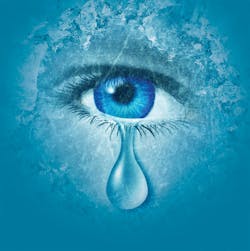Seasonal affective disorder and the winter blues: How the time of year may be affecting you and your patients
Amber Metro-Sanchez, BA, RDH
Every year, as fall approaches, I feel a bit of dread as the days become shorter and shorter. I love to be outdoors enjoying the sunlight as much as I can. When the seasons change and my chances of getting outside are diminished, I inevitably feel a case of the winter blues creeping in.
I live in Indiana, and during the depth of winter the state gets only about nine hours of daylight.1 When I get to work, it’s dark, and when I leave work, it’s dark. I find this lack of sunlight disheartening and I yearn for the burst of energy I feel when spring approaches. In midsummer, the light is present for most of my waking hours, lasting about 15 hours per day. This is by far my favorite time of the year as I can spend at least a few hours outside, even after my workday is over.
Mood changes are not uncommon because many people across the country are affected by the change of seasons. For some people this is a minor concern, but for others it can be quite debilitating. Winter blues is the less serious consequence of the seasonal change, and seasonal affective disorder (SAD) is the more life-altering condition. Both are more common than you might think. Overall, 6% of people in the United States have SAD and 14% of people are affected by the winter blues.2
Photo: © Skypixel | Dreamstime.com
Characteristics
SAD is classified as a specific type of depression that comes and goes with the seasons.3 It typically begins in the late fall and early winter and disappears in the spring and summer.
In order to be diagnosed with SAD, one must meet the complete criteria for major depression coinciding with specific seasons for at least two years. Some of the common signs include losing interest in activities that you once enjoyed, feeling depressed most of each day, feeling hopeless or worthless, and having problems associated with sleep. Along with this, a person may have difficulty concentrating, have a low energy level, feel agitated, and experience changes in appetite or weight. One of the most serious symptoms of depression is frequent thoughts of death or suicide.
Some of the symptoms specifically associated with SAD include low energy, overeating (especially craving carbohydrates), and weight gain. Hypersomnia, a term referring to excessive daytime sleepiness or excessive time spent sleeping, is another sign. The urge to withdraw socially, aka “hibernate,” is another sign of SAD.
Predisposing factors
One’s location is one of the biggest risk factors in the development of SAD since daily sunlight exposure plays an important role. SAD is most common in northern areas of the United States, with 9% of people living near the Canadian border experiencing this condition.4 In stark contrast, only 1% of residents of Florida, the “Sunshine State,” are affected by SAD.
Age, sex, and family history also play a role in developing SAD.3 Young adults have a higher risk of experiencing SAD than older adults, with the most commonly affected age group being 18–30. Females are diagnosed with SAD at four times the rate of men. In addition, people with a family history of depression are at a greater risk of being diagnosed with SAD.
SAD versus winter blues
The telltale signs of the winter blues are low energy level and general sadness.2 Other symptoms are a lack of motivation, not being as outgoing socially, and difficulty sleeping. These changes may be disheartening, but they do not affect a person’s ability to enjoy life overall. The symptoms of SAD are more severe and affect all aspects of someone’s life. Feelings of hopelessness and depression are pervasive.
Professionals often use the Seasonal Pattern Assessment Questionnaire (SPAQ) to screen for SAD and winter blues. This screening differentiates between these two conditions because a higher score is associated with SAD. Some of the criteria evaluated include the number of hours spent sleeping, weight changes, moods experienced, and energy levels. These are reported for each month (or season) of the year so that patterns can be discovered. Respondents also rate the degree to which seasonal changes cause “problems.” The complete form is available atguilford.com/add/forms/rosenthal2.pdf.
How to combat them
The first step to combating these conditions is to recognize the symptoms, whether they are in yourself, a family member, or a patient.2 The next step is to seek help from a qualified medical professional. Sometimes people will go to their physicians because they’re easily fatigued and they think that something is physically wrong with them, when actually the seasonal change is the root cause. Physicians can do a complete blood count and check vitamin D levels to rule out other factors.
There are a variety of treatment options available. One way to alleviate symptoms is to get sunlight exposure whenever possible. For me, that means going for a drive during my lunch hour with the sunshade on my moonroof open. Getting exercise also helps as it increases both serotonin and endorphin levels, which are the body’s “feel-good” chemicals. Thirty minutes of moderate activity on a regular basis has shown to be most effective.
Light therapy is another effective measure, with daily recommended doses provided by a light box. This repeated exposure to white fluorescent lights that imitate sunlight helps to regulate the body’s melatonin levels and is considered the standard of care for SAD. Cognitive behavioral therapy is a new treatment method with much potential as it involves identifying negative thoughts and replacing them with positive thoughts and ideas.3 If these treatment measures do not provide relief, antidepressants may be prescribed.
Taking care of yourself in general is another good way to fight SAD and the winter blues.2 Don’t isolate yourself; go out and do all the activities you enjoy with your family and friends. Make sure you get enough sleep and try to maintain the same sleep schedule. Eat a healthy diet and avoid the temptation to indulge in too many carbohydrates.
Broaching the subject
If a patient has any of these risk factors and it seems like the person is depressed or not keeping up with his or her normal oral hygiene habits, consider talking to the person about SAD and the winter blues. It could be easy to miss these signs and assume that the patient is being inattentive with home care, but as dental professionals, we need to think about whole-body health. Recommending that the person talk to his or her physician is a great first step.
For anyone experiencing SAD or the winter blues, it’s important to let them know that they do not have to emotionally suffer through winter. Many treatment options and lifestyle changes are readily accessible and can be easily implemented. As always, knowledge is key, and together we can help improve lives by spreading awareness about these conditions.
References available at rdhmag.com. Search “Metro-Sanchez.”
Amber Metro-Sanchez, BA, RDH, practices dental hygiene with Chris Bible, DDS, at Comfort Dental in Fort Wayne, Indiana. She also works as a professional educator on behalf of Waterpik. She was a member of the 2015 Colgate Oral Health Advisory Board. She is also a contributing author for the Colgate Oral Health Advisor web page. She can be reached at [email protected].

